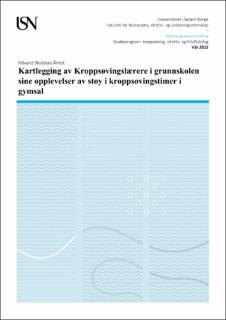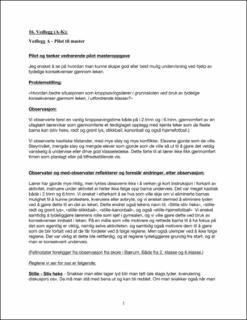| dc.description.abstract | Kroppsøvingslærerens arbeidsmiljø i forhold til opplevelse av støy er blitt lite forsket på. Effekten av støy er derimot godt dokumentert at kan være helseskadelig, og arbeidsmiljøloven setter i tillegg krav til hvilken eksponering for støy som er akseptabel. I denne oppgaven har jeg stilt spørsmål for å besvare hvordan tilstanden er ute hos kroppsøvingslærerne og hvordan de opplever støy i sine kroppsøvingstimer i gymsal.
Gjennom en innledende master-pilotoppgave, observerte vi først hvilken negativ effekt støy så ut til å ha på både gjennomføringen av kroppsøvingsundervisning samt trivsel og opplevd mestring hos lærer. I piloten så vi flere positive effekter ved å eliminere lyd og støy ved hjelp av konsekvenser i leken. Om øktene som her ble observert er representative for støy og kaos ellers i landet det vet vi ikke. Men kuriositeten rundt dette gjorde til at jeg i denne masteroppgaven bestemte meg for å kartlegge hvordan kroppsøvingslærerne opplever dette, med følgende problemstilling; «Hvordan opplever kroppsøvingslærere i grunnskolen støy i gymsalen i kroppsøvingstimer?»
Det ble gjennomført en kvantitativ undersøkelse, med spørreskjema. Spørreskjemaet ble distribuert til et utvalg kroppsøvingslærere i en stor by på Østlandet. 137 kroppsøvingslærere har bidratt til data ved å svare på spørreskjemaet. Skjemaet ble delt inn i ulike temaer som tok for seg opplevd utbredelse av støy, arbeidsmiljø og trivsel, kvalitet på undervisning, støy i ulike aktiviteter, årsak til støy og tiltak for å begrense støy. Nøkkelord i masteroppgaven er støy, arbeidsmiljø, kroppsøving, klasseledelse og akustikk.
Resultatene viser oss innenfor samtlige av temaene tydelige tegn til at kroppsøvingslærerne opplever mye støy på de like skolene og at dette oppleves som en utfordring hos mange av respondentene. Noen av kroppsøvingslærerne melder også om at støy i mindre eller liten grad utgjør et problem i enkelte av spørsmålene, så det er noen forskjeller, men flertallet er allikevel tydelig på de fleste spørsmålene.
Flertallet av respondentene mener at støy i kroppsøvingsfaget bør begrenses, og over halvparten av respondentene melder om at de ville trivdes bedre om de kunne eliminere støy i kroppsøvingstimer. Som forslag til tiltak melder noen av respondentene om at klasseledelse er et viktig tiltak som kan sørge for at støy ikke er et problem. Andre melder om at akustikken må utbedres og foreslår også formstøpte ørepropper og mikrofon til kroppsøvingslærerne. Noen melder også forslag til tiltak der man begrenser antall klasser i gymsal samtidig og antall elever i hver klasse.
Av aktivitetene i gymsal ser det ut som at stafett, men også ballspill skaper signifikant mest støy sammenlignet med lek, dans og turn. Vedørende støykildene som akustikk i gymsal, lyder fra selve aktiviteten og vokale lyder melder respondentene opplevelsen av støy på en skala fra en til fem, og ved en gjennomført anova-analyse ser det ut som at vokale lyder skaper signifikant mest støy, sammenlignet med de andre to.
Det ble gjennomført spearman´s rho analyse for å se på sammenhenger mellom rammefaktorer og støyvariabler. Vi har her funnet flere signifikante funn mellom rammefaktorer og ulike støyvariabler i korrelasjonsanalysen, der vi ser er at de kroppsøvingslærerne som melder om at det er mye gjenklang og dårlig akustikk i gymsal har signifikant korrelasjon med de fleste av opplevelse av mye støy i de fleste av spørsmålene, med noen få unntak. Dataene viser også oss en korrelasjon mellom at kvinner opplever oftere at de må anstrenge stemmen, og melder om at støy ville vært et problem for trivselen om de hadde undervist de fleste av sine timer innen kroppsøving.
Vi har også funnet at de som opplever støy som et problem forhold til at det oppstår flere konflikter eller at de må bruke mer tid på konflikter ser ut til å være respondenter som underviser på de laveste trinnene.
Kompetanse ser også ut til å korrelere med opplevd trivsel ved mange undervisningstimer i kroppsøving, men korrelerer negativt, slik at de som har høy kompetanse melder om at det ikke ville påvirket trivselen negativt om de hadde flere timer. Med andre ord kan dette tolkes dithen at de med mer kompetanse tenker at de mestrer kroppsøvingsfaget bedre enn de uten kompetanse. Vi mistenker at dette kan ha med klasseledelse å gjøre, at man med mere kompetanse opplever at man har flere muligheter til å ha kontroll og justere støynivået gjennom egen klasseledelse. Vi så også en korrelasjon på samme støyvariabel med antall økter, og ettersom antall økter og kompetanse også korrelerer, kan det tyde på at de som har flere økter også har høyere kompetanse og derav mener at det ikke vil påvirke trivselen negativt med flere økter. Det kan også tenkes at siden disse allerede har mange økter, og samtidig melder om at det ikke ville vært et problem, at de allerede i sin hverdag kjenner på mestring og at dette for disse ikke er et hypotetisk scenario, men heller dagens realitet. Av respondentene er det 64.2% prosent av respondentene som har mye kompetanse i faget, men kun 26,2% som underviser mer enn 7 økter i uka, mens 56.9% underviser mer enn 3 økter i uka. Vi kan anta at de med høy kompetanse er fordelt på 3 økter og opp, siden disse korrelerer. De som underviser mange økter melder om at støy i tilsvarende stor grad bør begrenses i kroppsøvingsfaget. De med mange økter melder også om at man mener støy påvirker kvaliteten til undervisningen negativt. | |
| dc.description.abstract | Not much research has been done on the physical education teacher's working environment in relation to his experience of noise. The effect of noise, on the other hand, is well documented to be harmful to our health, and the Norwegian law for working environment (arbeidsmiljøloven) also sets requirements for to what extent exposure to noise is acceptable. In this thesis, I have asked questions to answer how the physical education teachers are doing in relation to this and how they experience noise in their physical education lessons in the gymnasium.
Through an initial master's pilot project, we first observed the negative effect noise seemed to have on both the implementation of physical education teaching as well as the teacher's well-being and perceived mastery. In the pilot, we saw several positive effects by eliminating sound and noise with the help of consequences in the game. We do not know whether the sessions observed here are representative of noise and chaos elsewhere in the country. But the curiosity surrounding this made me decide to dedicate this master's thesis to a survey on how the physical education teachers experience this, with the following problem; "How do primary school physical education teachers experience noise in the gymnasium during physical education classes?"
A quantitative survey was carried out, with a questionnaire. The questionnaire was distributed to a selection of physical education teachers in a large city in Eastern Norway. 137 physical education teachers have contributed to the data by answering the questionnaire. The form was divided into different themes that dealt with perceived prevalence of noise, working environment and well-being, quality of teaching, noise in various activities, cause of noise and measures to limit noise. Keywords in the master's thesis are noise, working environment, physical education, classroom management and acoustics.
The results show us, within all of the different themes, clear signs that the physical education teachers experience a lot of noise in their classes and that this is experienced as a challenge by many of the respondents. Some of the physical education teachers also report that noise is to a smaller or lesser extent a problem in some of the questions, so there are some differences, but the majority is still clear on most of the questions.
The majority of respondents believe that noise in physical education should be limited, and over half of the respondents report that they would feel better if they could eliminate noise in physical education classes. As a suggestion for measures, some of the respondents report that class management is an important measure that can ensure that noise is not a problem. Others report that the acoustics need to be improved and they also suggest molded earplugs and a microphone for the physical education teachers while in class. Some also report proposals for measures where the number of classes in the gymnasium at the same time and the number of pupils in each class are limited.
Of the activities in the gymnasium, it appears that relays, but also ball games, create significantly more noise compared to games, dancing and gymnastics. With regards to the noise sources such as acoustics in the gymnasium, sounds from the activity itself and vocal sounds, the respondents report the experience of noise on a scale from one to five, and in a carried out anova analysis it appears that vocal sounds create significantly the most noise, compared to the other two.
Some spearman's rho analysis was carried out to look for connections between framework factors and noise variables. Here we have found several significant findings between frame factors and various noise variables in the correlation analysis, where we see that the physical education teachers who report that there is a lot of reverberation and poor acoustics in the gymnasium have a significant correlation with most of the experience of a lot of noise in most of the questions, with a few exceptions. The data also shows us a correlation between women experiencing more often that they have to strain their voices, and reporting that noise would be a problem for well-being if they had taught most of their lessons in physical education.
We have also found that those who experience noise as a problem in relation to the fact that more conflicts arise or that they have to spend more time on conflicts seem to be respondents who teach at the lowest levels.
Competence also appears to correlate with perceived well-being with those who have many classes in physical education, but correlates negatively, so that those with high competence report that it would not affect their well-being negatively if they had more hours. In other words, this can be interpreted as meaning that those with more competence think that they master physical education better than those without competence. We suspect that this may have something to do with class management, that with more competence one feels that one has more opportunities to have control and adjust the noise level through one's own class management. We also saw a correlation on the same noise variable with the number of sessions, and as the number of sessions and competence also correlate, it may indicate that those who have more sessions also have higher competence and therefore believe that it will not affect well-being negatively with more sessions. It is also conceivable that since these have already many sessions, and at the same time report that it would not be a problem, that they already know coping in their everyday life and that for them this is not a hypothetical scenario, but rather today's reality. Of the respondents, 64.2% of the respondents have a lot of expertise in the subject, but only 26.2% teach more than 7 sessions a week, while 56.9% teach more than 3 sessions a week. We can assume that those with high competence are teaching from 3 sessions and up, since these correlate. Those who teach many sessions also report that noise should be limited in physical education. Those with many sessions also report that they believe that noise affects the quality of teaching negatively. | |

